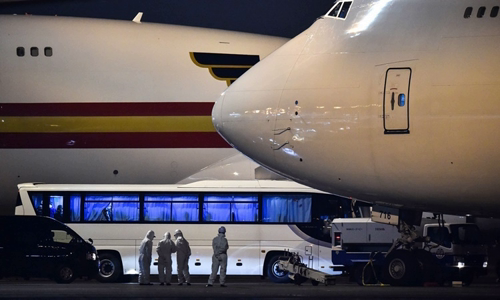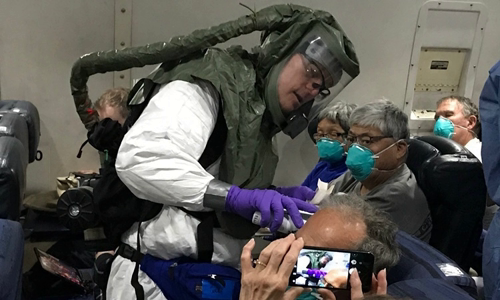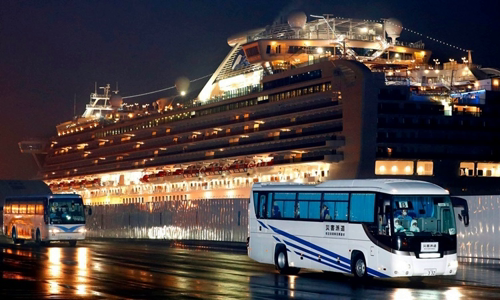Stepping on the plane to return to the country, American passengers were evacuated from the Diamond Princess ship.
The day before 328 American passengers were taken off the isolated Diamond Princess yacht at the port of Yokohama, Japan, the US Embassy in Tokyo informed them that those who were positive for the virus would not be allowed to board the plane. The country is governed by the Ministry of Foreign Affairs.

US government aircraft waited at Haneda Airport in Tokyo to bring citizens who had just been evacuated from Diamond Princess Photo: AFP
But on the morning of February 17, as passengers began crowding into two refurbished cargo planes to bring them back to military bases in California and Texas, some noticed the areas. separate from the rest.
The truth is that after 12 days of being stuck on a yacht with an ever-increasing number of people infected with nCoV, they are now sitting on the same plane with those carriers who have long sought to stay away.
"We didn't know anything until the plane flew in the sky," said Carol Montgomery, 67, from San Clemente, California. "I see an area covered by plastic curtains."
While the plane has not yet landed in Japan, the State Department and the US Department of Health issued a joint statement saying that the test results of 14 passengers tested two to three days ago were positive and they were on Road to the airport by bus.
In fact, US officials conducted evacuation of citizens before the test results of the 14 people mentioned were unknown. But because the evacuation process had begun before the Japanese authorities passed the results to the United States, they decided to let those who were infected but had no symptoms on board, arranged to sit them in the back, separated by other passengers by three-meter-tall plastic curtains.
The US decision was the latest chaotic twist in the two weeks the Princess Diamond was isolated.
Just as the US sent citizens home and some other countries such as Australia, Canada and South Korea are preparing plans to evacuate citizens, the Ministry of Health of Japan said there were 99 more people identified to be infected with viruses, raising The total number of people positive for nCoV was 454, including Japan's third public health official, who was infected by the virus while caring for passengers and crew members.
The unforeseen increase in the number of virus infections and U.S. efforts to bring citizens back home, even after some people were found infected, raises questions and criticism of the conduct. outbreak treatment on board.

Passengers on the plane are temperature checked Photo: NYTimes
"The isolation of the ship has finally failed miserably," said Eiji Kusumi, a doctor specializing in infectious diseases at Navitas Clinic in Tokyo, Japan. "We should learn from this story, that isolating a ship is impossible. We should not repeat mistakes in the future."
After the long isolation period in Japan, the US government encouraged citizens aboard the Diamond Princess to accept an evacuation flight. The effort to get them off the train took days to plan, review, check passports, and finally, the passengers were taken on buses from the Port of Yokohama to Haneda Airport in Tokyo. Even so, there are still 61 US citizens who decided to stay.
Asked why U.S. officials still began to evacuate passengers despite not knowing the results of their tests, Dr. William Walters, director of medical affairs at the State Department, told reporters on February 17. that this is "unpredictable".
According to the State Department, US citizens are allowed to take about 15 buses to the airport. Upon learning that someone was positive for the virus, the infected passengers "were moved as quickly and safely as possible to a dedicated isolation area" at the end of the aircraft.
"In the quarantine area, they cannot create any additional risks," Dr. Walters said.
After landing, 14 infected people were taken to hospital for surveillance and treatment. The remainder were transferred to Travis Air Force Base in California or San Antonio Base in Texas. They will stay here for another 14 days.
When one of the planes landed in California, a long line of military officials, the Centers for Disease Control and Prevention, and the Department of Homeland Security welcomed the passengers with prominent banners. "Welcome home."
After passing through a quarantine tent, they continued to be assigned to the apartments inside the base.

The bus takes American citizens from the Port of Yokohama to Haneda Airport in Tokyo to return home Photo: AP
"They bring in experts from across the country," said Sarah Arana, 52, a social health worker from Paso Robles, California. "They put a tremendous amount of resources. I was overwhelmed."
Epidemiologists say US officials had to make a difficult choice when deciding to allow infected passengers to evacuate.
"You don't want to spread the infection to anyone on board who has tried to avoid getting the virus while on board," said Dr. Allen Cheng, an infectious disease specialist at Monash University in Melbourne, Australia. consider.
Australia is planning to take about 200 citizens from their yacht Diamond Princess tomorrow. Dr Cheng said Australia had decided "anyone who is ill or shows signs of illness within the next 48 hours will have to stay in Japan and be hospitalized".
During a press conference yesterday, Shigeru Omi, president of the Japan Public Health Organization, confirmed that the country made the right decision to isolate the ship on February 3 in Yokohama. "At that time, the international community was trying to stop the virus," he said.
According to Japan's Ministry of Health, at least 55 Americans aboard Diamond Princess have been infected with nCoV. Many of them are being treated at hospitals in Japan.
John Haering, 63, from Tooele, Utah, USA, was transferred to a hospital in Chiba province last week with a fever and a positive virus test result. He said he felt like he was trapped in an isolated room.
Melanie, his wife, returned to the United States on a government flight.
"I'm glad she left here and will get more attention when she comes back to the US," he said. "But I'm also sad. You always feel lost when someone leaves."
Haering no longer displayed symptoms of fever or fever, but CT findings showed he had signs of pneumonia. He did not know how long he would have to stay in Japan.
"I will have test results tomorrow," he said. "I asked the doctor if the results were negative, he just shook his head and said 'I don't know'. There are many things they don't know."
Haering said he did not receive any information from Princess Cruises, the company that operates the Diamond Princess, from admission to the present. Until February 16, he did not hear from the US Embassy in Tokyo.
"It's scary. I feel like I'm abandoned," he said.
Tung Pi Lee, 79, a retired doctor, was taken to a hospital in Tokyo for nCoV infection while his wife, Angela, returned to California on a government flight. Some of their relatives are among 14 passengers infected with the virus but still boarding. Two were taken to Nebraska and another stayed in California for treatment.
"I'm glad that my aunt and uncle came back to the US and were treated in the US," said JoAnn LaRoche Lee, Lee's daughter. "If I was left in Japan, I didn't know what would happen to them."
In an effort to coordinate looking after her father in Tokyo with siblings in the US, she said it was like "a never-ending nightmare".
Places where Covid-19 patients are infected. Click on image to see details.



 KaraL.Whitaker
KaraL.Whitaker







